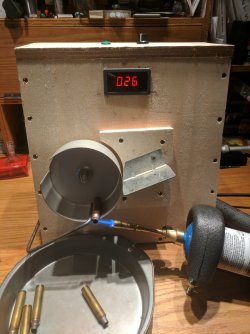I became interested in annealing in 2021, and like you was dismayed by varying opinions in the shooting community. Due to my engineering background, I then turned to the scientific community for information and discovered that much of the information on annealing, propagated in the shooting community is erroneous, mostly due to a lack of understanding as to the physics underlying brass annealing. I discovered the following:
1) The microscopic grain structure of brass changes as you work it, making it harder and more brittle.
2) Heating brass for a sufficient amount of time will change the microscopic grain structure of brass, returning it to its pre-worked state.
3) Brass begins to glow at a specific temperature (between 950ºF and 1050ºF depending on the exact composition) and melts at 1710ºF.
4) Brass cannot be "over annealed"; that is applying additional heat/time does not further change the microscopic grain structure beyond a certain point (unless of course you melt it).
5) You only want to anneal the neck and shoulder of a case, and not the base, so the shorter the annealing time, the less heat will be conducted down the case to the base.
6) Quenching brass does not affect its microscopic grain structure in any way.
Annealing brass is a function of temperature and time. The 700ºF that is often propagated among shooting community as the proper brass annealing temperature actually needs to be maintained for 1 hour to anneal brass. The following formula is used to calculate the time and temp to anneal brass:
B=1.38065x10^-23 (Boltzmann constant)
E=0.327x10^-18 (constant for the material, in this case brass)
T1 in Kelvin = 644º (700º F)
t1 in sec = 3600 (1hour)
T2 in Kelvin = target temp
t2 in sec = time to anneal
t2=t1*exp^(-E/B*(1/T1 - 1/T2))
This is easy to plug into Excel and if you pick 810.9ºK (1000ºF) for your target temp you will anneal in 1.88 seconds. Again note that brass starts to glow between 950ºF and 1050ºF depending on the exact composition. Using 900ºF changes the required time to 16.1 seconds.
I use the glow of the brass to gauge my temperature, understating that I am not going to over anneal if I keep it there for 2 sec or 5 sec. If you want to be more precise with the temp then you can invest in an infrared thermometer.
I cannot stress enough that the key to annealing is getting the brass to between 1000ºF and 1200ºF for a few seconds (remembering you cannot over anneal unless you get close to its melting range), ensuring it is not under annealed.
View attachment 597121



